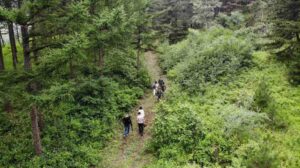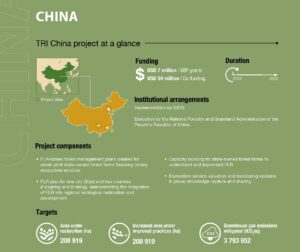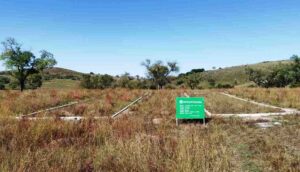The IUCN‘s TRI (The Restoration Initiative) China project has created an online forestry recovery course that documents and shares the Mulan State Forest Farm’s (Mulan SFF) approach to forest restoration and management with foresters across the country.
In the north-eastern region of China, a three-man camera crew is traversing the Mulan SFF. The Mulan SFF is one of eight sites where the TRI China project is active and well known for its unique geographical features and its innovative approach to forest restoration.
 The camera team is here to collect footage to showcase the site’s management principles for an online forestry course co-developed by the TRI China project and the Mulan Forest Management Department.
The camera team is here to collect footage to showcase the site’s management principles for an online forestry course co-developed by the TRI China project and the Mulan Forest Management Department.
At the core of the Mulan forestry course lies the FLR approach, which prioritizes not only the ecological function of forest landscapes but also the myriad of ways humans benefit from and rely on such landscapes.
This is reflected in the Mulan SFF’s management strategy, which aims to not only increase the overall forest cover and optimize forest vegetation through reforestation but to also ensure ecosystem services, such as the forest’s unique geographic role as an ecological barrier against the sand-carrying winds headed for Beijing and Tianjin.
 In addition to prioritizing windbreaks, the Mulan SFF prioritizes water conservation and sand fixation, which bolsters the forest’s ability to serve as a protective barrier and limit the amount of sand and other particles deposited in the cities. Other SFF sites working with the TRI China project are following a similar approach to prioritize ecosystem services based on respective geographical contexts.
In addition to prioritizing windbreaks, the Mulan SFF prioritizes water conservation and sand fixation, which bolsters the forest’s ability to serve as a protective barrier and limit the amount of sand and other particles deposited in the cities. Other SFF sites working with the TRI China project are following a similar approach to prioritize ecosystem services based on respective geographical contexts.
Tian Guoheng, the director of Mulan SFF, believes that sharing first-hand practical experiences will improve the visibility of the FLR approach, and will build foresters’ ability and self-confidence to use it to grow flourishing, more diverse and productive forests across the country.
There are approximately 4 000 SFFs in China, covering 77 million ha or 8 per cent of the country’s land territory. Historically, the management of these SFFs has focused on maximizing timber production and typically by planting just one or two high-yielding species of trees.
However, experience and studies illustrate how these forest plantations are particularly susceptible to disease and other shocks, delivering fewer ecosystem services than forests managed to more closely resemble primary forests or forests that are largely undisturbed from human influence. In contrast, natural forests, composed of many native tree species, store more carbon, have greater resilience against pests and diseases, and provide more suitable growing conditions and habitats for at-risk plants and animals.
Out from behind the drawing board
 A team of 32 people, sourced from both the TRI China project and Mulan SFF staff, conceptualized the course of nine video lessons. It took three months of planning, writing and the incorporation of suggestions from outside experts to finalize the lesson scripts.
A team of 32 people, sourced from both the TRI China project and Mulan SFF staff, conceptualized the course of nine video lessons. It took three months of planning, writing and the incorporation of suggestions from outside experts to finalize the lesson scripts.
The video lessons outline how FLR management theory and principles – such as moving away from monoculture tree farming and applying new technologies – can result in more productive forests, including improved ecosystem services, higher quality seedlings and timber.
The lessons also highlight strategies for tending forests at various stages of development.
According to Zhang Songdan, Chief Technology Adviser of the TRI China project, the course has the potential to establish, localize and mainstream FLR methods in China, especially in other SFFs. “Forest management in China is shifting from increasing quantity to improving quality,” she says.
Using the Mulan SFF as an example, other SFFs can use the FLR approach to better assess their own needs, goals and activities.
After eight weeks in post-production, Guoheng is thrilled with the final product. “It allows us to review familiar knowledge [from] a more systematic, in-depth and objective perspective,” he says.
It also helps SFF teams across the country better understand FLR methods and to discover areas for improvement. In 2021, they completed a successful pre-screening of the course.
In 2022, they shared the Mulan forestry course with students, agroforesters and SFF staff. They are even considering distribution through other channels, such as incorporation within forestry school curricula.
Whether other SFFs follow suit and produce their own video courses is yet to be seen, but even if the Mulan forestry course stands alone, it fills a critical knowledge gap that complements the more theoretical information currently available.
Not only does the Mulan forestry course make a comprehensive contribution to forest restoration efforts and the application of FLR principles in China, which was previously unavailable to many, but it also encourages other SFFs to summarize their own knowledge and experiences – even if they don’t end up on video.

